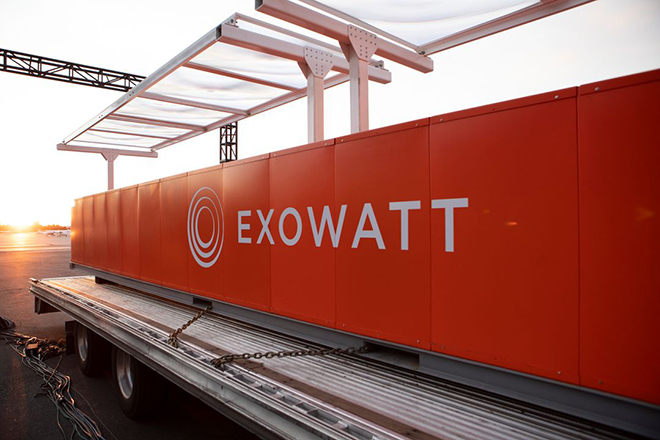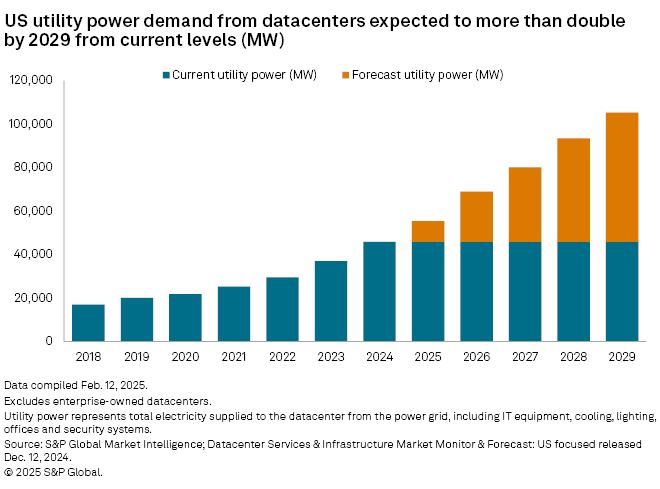S&P Global Offerings
Featured Topics
Featured Products
Events
S&P Global Offerings
Featured Topics
Featured Products
Events
S&P Global Offerings
Featured Topics
Featured Products
Events
Banking & Capital Markets
Economy & Finance
Energy Transition & Sustainability
Technology & Innovation
Podcasts & Newsletters
Banking & Capital Markets
Economy & Finance
Energy Transition & Sustainability
Technology & Innovation
Podcasts & Newsletters
S&P Global Offerings
Featured Topics
Featured Products
Events
19 Mar, 2025

By Zack Hale

|
Exowatt's P3 full-stack system generates and stores solar energy, enabling customers to meet peak power and dispatch demand needs. |
As orders for new natural gas-fired turbines face five-year delivery backlogs, Miami-based startup Exowatt Inc. is looking to scale production of its solar-plus-thermal energy storage system to meet roughly 100 GWh of datacenter power demand within the next few years at 1 cent/kWh.
That would represent a roughly 1,000-fold jump for the company, Exowatt co-founder and CEO Hannan Happi said during a March 11 interview at the CERAWeek by S&P Global conference in Houston.
Exowatt was founded in 2023 by Happi and Jack Abraham, managing partner and CEO of Atomic Management LLC, a San Francisco-based startup studio and investment fund.
Sensing a market opportunity in meeting the growing electricity needs of artificial intelligence applications, the two founders launched Exowatt with the goal of delivering power solutions to datacenter customers at a target price of 1 cent/kWh.

For context, industrial electricity customers paid a little over 8 cents/kWh on average in 2024, according to the US Energy Information Administration. US datacenter customers, with operations that typically run 24/7, are now signing power purchase agreements in the range of 10 cents/kWh to 13 cents/kWh, Happi noted March 11.
"We said, 'One cent per kilowatt-hour is where we need to get to,' and we started working our way backwards from that," Happi said.
'A sophisticated brick' for storing solar energy
That naturally led the Exowatt team — currently numbering over two dozen employees and set to double in size by the end of the year — to solar energy, Happi explained.
US solar installations have exploded in recent years largely due to a steady decline in the price of solar modules. In addition to cost considerations, Exowatt was drawn to the modular design of mass-produced solar panels.
However, solar's intermittent nature is not well suited for baseload applications like datacenter operations, Happi noted.
"Traditionally, the way to solve [that] has been to add electrochemical batteries, which are very expensive," Happi said. "So, we came up with the concept of capturing solar energy in the form of heat and storing it in a battery."
The resulting product — Exowatt's flagship P3 full-stack renewable energy system — was unveiled last year at a renewable energy conference in Anaheim, California. The P3 system takes its name from three core components: an optical solar lens, a high-temperature thermal energy storage system and a modular heat engine.
Happi likened the storage component to "a sophisticated brick."
"We're heating it up using the incoming solar energy, and then we're retaining that heat inside an insulated enclosure and extracting it when needed and converting it to electricity," he said.
|
Exowatt co-founder and CEO Hannan Happi. |
While lithium-ion batteries are typically limited to four hours of duration, the Exowatt system can operate on a daily dispatch cycle ranging from 16 to 24 hours, Happi said.
Heat is also "two orders of magnitude" cheaper to store than electricity, he added, allowing for the storage of energy "much more cost-effectively over longer durations."
The entire P3 system is about the same size as a shipping container.
"The idea is that you can linearly scale the number of modules to meet any project size, whether it's a 100-megawatt datacenter or a 1-megawatt site or some other type of application," Happi said.
He noted that the quoted price of 1 cent/kWh does not account for investment and production tax incentives in the Inflation Reduction Act. The P3 system is also manufactured with materials sourced from within the US, Happi said.
"That kind of takes away the perceived or real market risks around tariffs, as well," he said.
Use cases, scaling efforts
Exowatt envisions a range of applications for the P3 system. In most use cases, the datacenter customer would remain connected to the broader power grid "as backup" while primarily relying on the P3 system for baseload generation, Happi said.
Customers can also use the P3 system to reduce regional peak demand charges, he noted.
In addition, datacenter customers could use the P3 system to go completely off the grid and avoid lengthy interconnection queue processing times, Happi said.
To reach its scaling goals, Exowatt is currently working with contract manufacturers throughout the US. The manufacturers, located in California, Florida, Texas and Utah, work with other major energy companies like Tesla Inc., said Happi, a mechanical engineer by training who previously worked for Tesla as a senior operations analyst.
Happi acknowledged a wide band of uncertainty as to how much projected datacenter demand will materialize on the US power system by the end of the decade.
"All I can say is that there has already been a substantial amount of capital put into datacenter builds that are going live in the next three to four years," he said. "That capital is committed, and that alone is worth hundreds of gigawatt-hours."
Exowatt closed an initial round of $20 million in seed funding last year with backing from Sam Altman's OpenAI LLC, the pioneering AI company behind the ChatGPT large language model.
Happi told Platts, part of S&P Global Commodity Insights, that Exowatt will likely announce the results of an additional funding round next month.
"Investor interest in the company has been similar to the customer interest — just really overwhelming," Happi said. "I think we're very well positioned in that sense, and we'll continue to work with both our equity partners and other financial and debt partners to scale in the coming years."
